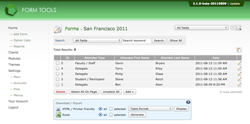Form Management
Form Management
Overview
The power and flexibility of Form Tools is in its interface for managing your forms. There, you can add new forms for storage, modify existing forms, add and remove form fields, add and change multi-select field options like radio and dropdown boxes, specify locations on your server where files should be uploaded to, create any number of emails to be sent based on certain event triggers, define ways to subdivide and organize your form submissions, change the database column names themselves and much, much more.
Integrating your forms
Form Tools can store submission data from forms from any location. If you chose to, you could install the program on your website then use it to store form submissions from multiple client websites. And since you can specify the redirect URL for each form (i.e. where the user gets sent after submitting a form), you can redirect each user back to the appropriate website in a seamless transaction. If need be, you can specify form field data to get passed back through the query string - allowing "receipt" or "thankyou" pages to display personal information, e.g. "Thanks for submitting the form, John!"
Form Tools is compatible with multi-page forms and can process form submissions in two ways: a "direct" submission, in which the form submits the data directly to a file called process.php, found in the root Form Tools folder. Or secondly, the submissions can be submitted through the API. The API is a set of functions for things like adding submissions to the database and displaying the data in your webpages. Generally speaking, using the API is a better approach: it provides FAR more control and is designed for things like multi-page forms, adding CAPTCHAs to your forms, displaying images as they are uploaded through the form, handling integration with online payment gateways and more. But this additional functionality makes it more complicated: so you may well wish to stick with the simpler "direct" approach, depending on your needs.
The following pages explains all of the subjects mentioned in brief above, hopefully answering the majority of your questions. If you can't find the answer to your question here in the user doc, just post it in our forums!
